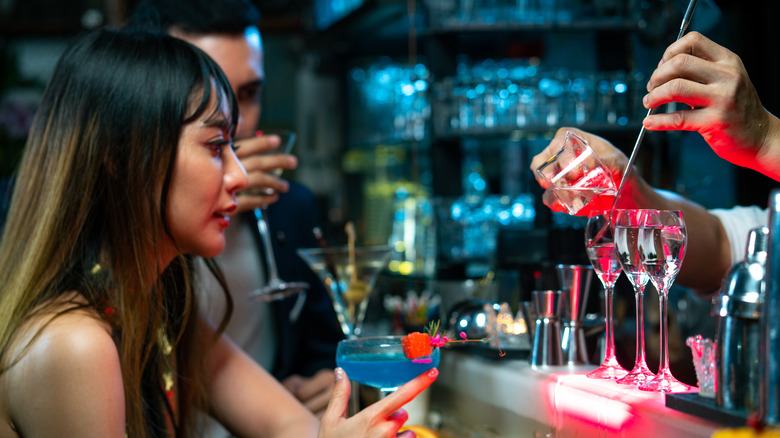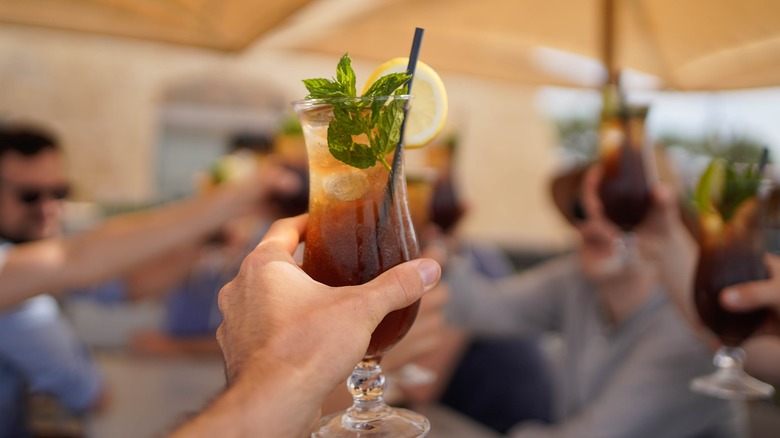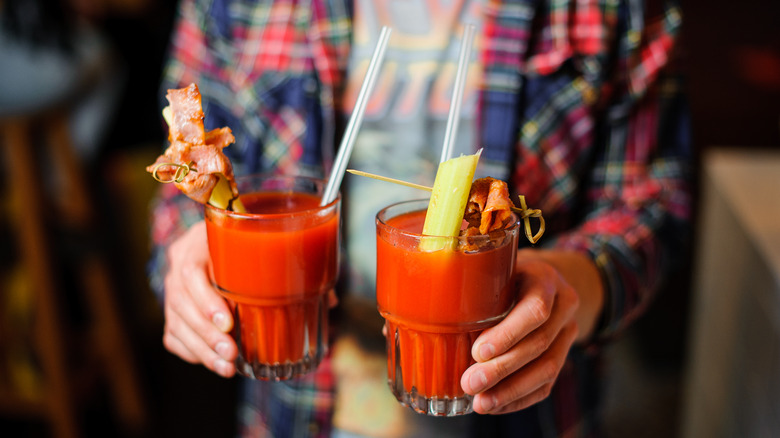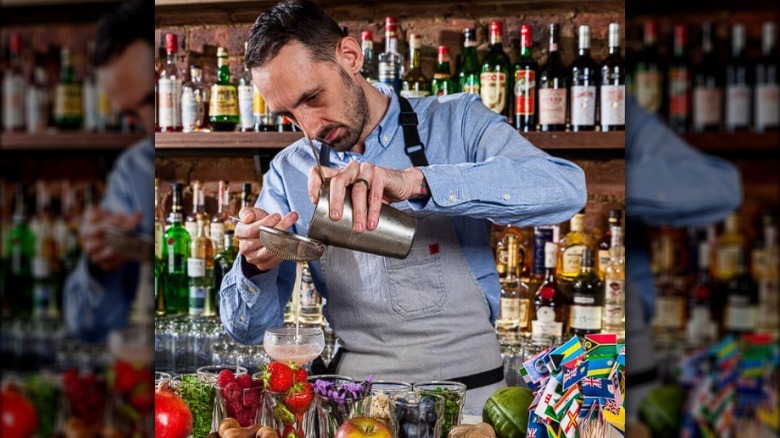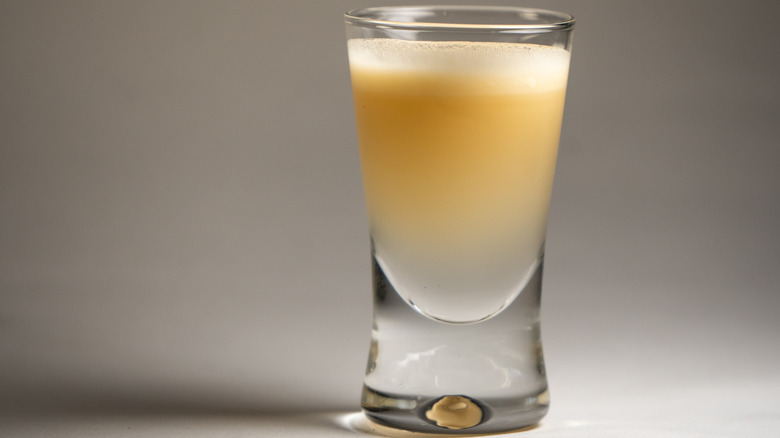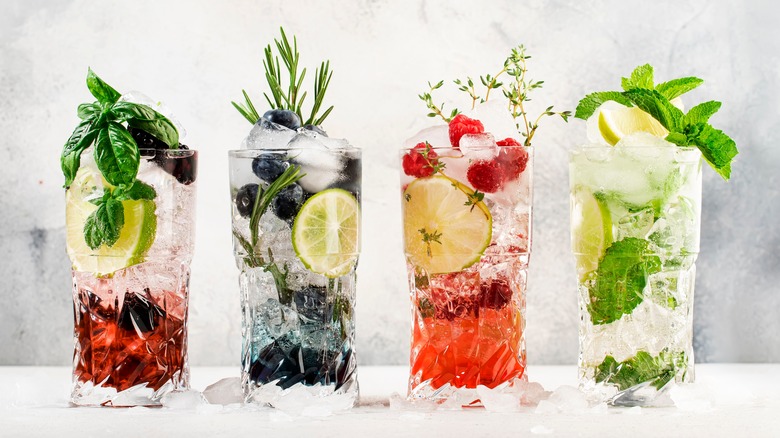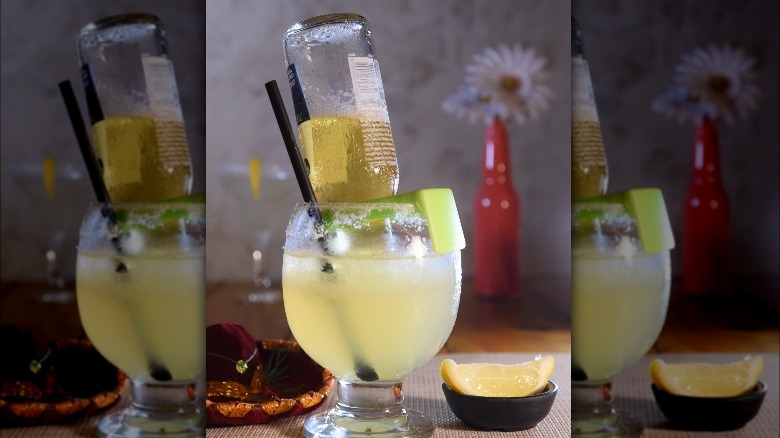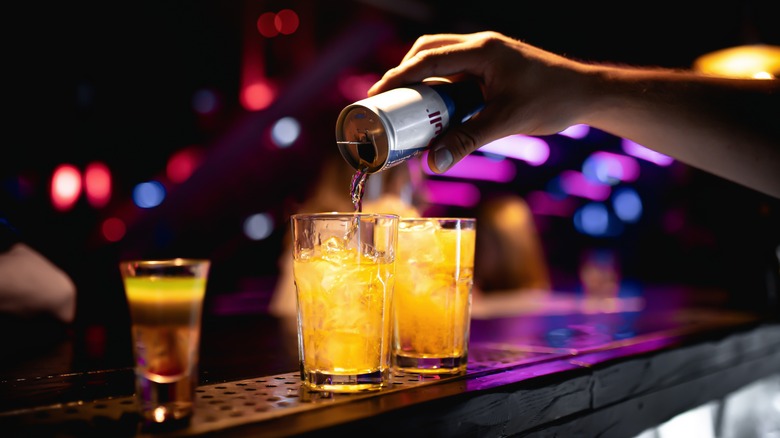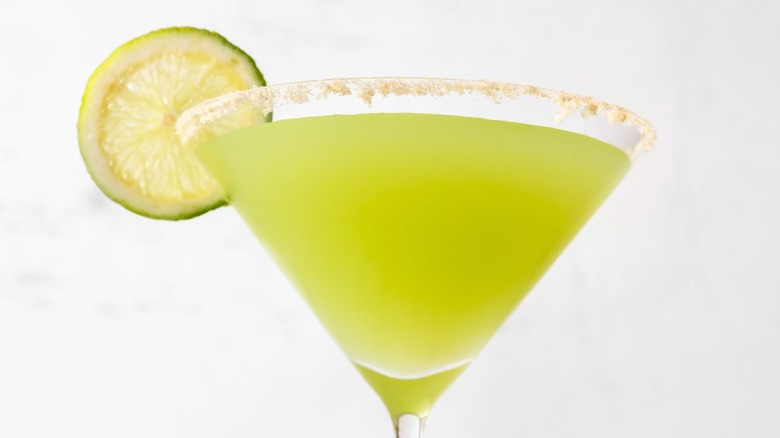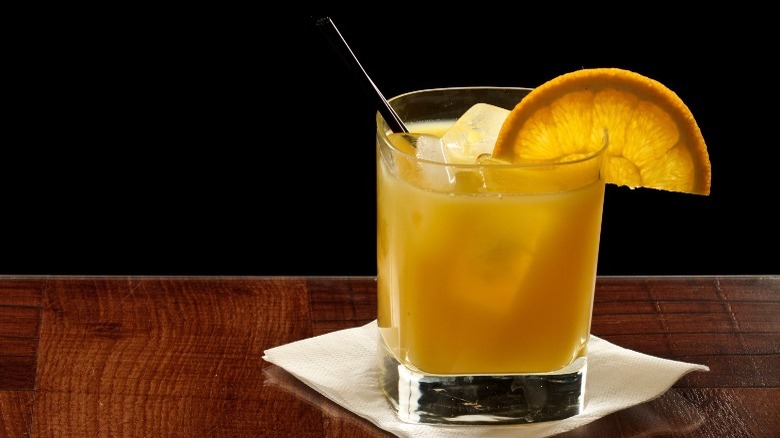11 Drinks That Are Red Flags For Bartenders
Have you heard the joke about the rabbit, the bank robber, and the giant zucchini who walk into a bar? Bartenders wish that red flags were that simple. Seasoned mixologists are always looking for warning signs of potential mischief or mayhem. A red flag can be as simple as a group of friends at a table getting boisterous or a glare from a lone person in the corner.
The drink itself can often alert the bartender if a patron will end up stumbling home wearing a roll of wet paper towels as a hat or if the makings of a hazardous situation are in play. Cocktails can convey "The person ordering me is an inexperienced and clueless patron," or they can hurl a flag across a dining room like a facemask in the red zone, offering a heads up to the barkeep that it's going to be "one of those nights."
Now, keep in mind that we'll be doing a bit of generalizing here, so please don't worry if a drink sounds too familiar. Drinking should be fun, which is exactly what we're going to have. But there are some honest-to-goodness annoyances on this list and potentially dangerous scenarios that everyone should be aware of. So come behind the bar with us and learn why some drinks can be potential red flags for bartenders. Cheers!
1. Angel Shot
We'll start the list with the most critical "drink" every patron and bartender should know. The Angel Shot is a fictional drink that is actually a code invented to send out a signal for help to a bartender, server, or any staff member. Generally, a woman who orders this beverage is asking the employee to intervene on their behalf because the date they are on may have gone south quickly. More and more restaurants are now getting out the word about ordering an Angel Shot if the need ever arises by posting messages in the restroom for anyone feeling pressured, harassed, frightened, or threatened by the person they are with.
Many bars, restaurants, and clubs — like The Exchange, a mammoth 7,200-square-foot nightclub in Minneapolis — have adopted additional Angel Shot code words to keep women safe, which gives the staff member further instructions. For example, ordering the drink "neat" requests an escort to the car, whereas "with ice" means a cab ride is needed, and "with lime" means "call the police." Bustle reports that up to 80% of women expect sexual harassment during a night out, which is why more and more venues are posting such instructions in ladies' rooms internationally.
If you or anyone you know has been a victim of sexual assault, help is available. Visit the Rape, Abuse & Incest National Network website or contact RAINN's National Helpline at 1-800-656-HOPE (4673).
2. Long Island iced tea
The Long Island iced tea: These four words may conjure up a hot day at your favorite pool bar or a delicious drink that goes down as smoothly as a Chris Isaak song, but for us bartenders, it's a red flag. The drink has several origins, and each story is as believable as the next. Bartender Robert "Rosebud" Butt claims that he first built the cocktail while competing in a Triple Sec-hosted cocktail-making competition in 1972 at the wildly popular Oak Beach Inn — formally located on Long Island's Jones Beach. Another story hails from Kingsport, Tennessee, where they also have a "Long Island." During prohibition, Charlie "Old Man" Bishop created a drink while home-brewing with very similar ingredients to the now-famous cocktail. Which folklore is true is anyone's call, but what is true is that the beverage can put the most seasoned drinker on a fast track to a short night.
The Long Island features "clear liquors": vodka, rum, gin, tequila, triple sec (or the higher-end Cointreau), added sour mix, cola, and often a splash of OJ. The mixture tastes almost identical to sweet tea but delivers a not-so-sweet wallop. Liquor Laboratory includes it as one of the strongest drinks to order at a bar, as each of the clear liquors has an average alcohol by volume percentage (ABV) of 40%. Which, if doing the math, seems like enough alcohol to liquefy a red flag, never mind raising one.
3. Flaming shots
Name your flame: Backdrafts, Drunken S'Mores, Dragon's Breath — no matter the title, drinks that require a bartender to recall where the fire extinguisher is stored belong in the "red flag" category. Wine Enthusiast visits the history of flaming cocktails, which seems to have been ignited by the Blue Blazer — a concoction of boiling water and whiskey with a dash of sugar. The drink would be lit on fire, creating a mesmerizing blue flame when poured. Although this was more for dramatic effect, some pyro-imbibers justified the act for culinary purposes because the fire would dampen the sting of the whiskey, according to David Wondrich, author of the historical cocktail book "Imbibe!" and featured writer of Imbibe magazine.
Flaming cocktails' popularity spread throughout the 1890s with the addition of brandy, rum, and other spirits (via Wine Enthusiast). Trends evolved into elaborate "flaming tiki drinks" in the 1930s and beyond. Today, you may find it as a "red flag" in the form of a 22-year-old with a penchant for showing off while throwing down a Flaming Dr. Pepper.
However, insurance companies point out that white-hot glass can create a perma-grin scar (think The Joker from "Batman"). Additionally, there is a laundry list of dangers that make mixing alcohol and fire a bad mix, from fast-spreading flames and fractured glassware (via Society Insurance) to turning yourself into the guy on Pink Floyd's "Wish You Were Here" album cover photo. We bartenders prefer fire-free consumption, but if you have to get your flame on, remember rule number one: Extinguish before drinking.
4. Top shelf Bloody Mary
Ordering Belvedere vodka in your Bloody Mary may create anything from a red flag to a simple turn-their-back eye roll from the bartender. From hangover cures and down-and-dirty beach picnics to lavish brunches, this cocktail is beloved, as are top-shelf vodkas, such as Grey Goose, Chopin, Kettle One — and any other expensive vodka that should not end up in a Bloody Mary!
As discussed by LBS Bartending School, there are many differences between top-shelf and well drinks. Depending on the bar, well drinks can be a less expensive but well-respected label as the generic version of a named brand spirit. Ordering "vodka" or "scotch," for example, would have the bartender reach down to their "speed rack" and grab a lesser-priced bottle, and speed racks may be filled with excellent brands.
There are many reasons to skip top-shelf liquor at a bar: Adding it to mixers that hide its taste is one of them. The top-shelf brand's smoothness, richness, and complex flavors are meant to be savored. Adding these liquors into overly sweet, rich, or salty mixers only puts more money into the register and hangs a red flag over your head that may just read "inexperienced drinker." This rule applies to ordering an Appleton Estate 21-year-old rum and coke or a High West Whiskey and ginger ale, just as a couple of examples.
5. Commonwealth
Ranked no. one on Liquor.com's "most complicated cocktails" list, the Commonwealth has 71 ingredients, making it a perfect example of a "red flag" beverage. This drink was created for the 2014 Commonwealth Games in Glasgow, and we're pretty sure that no bar in your neighborhood would have all the ingredients, which range from utazi leaves from Nigeria and breadfruit from Tuvalu to devil's horsewhip from Montserrat. The Drinks Business offers the entire record-breaking list of ingredients if pulling your own hair out for a cocktail party is your thing. But why would such a complex cocktail become a red flag? Not because it's impossible to make — but because the bartender has no idea where to start.
For some unknown reason, a percentage of patrons look at playing a game of "stump the barkeep" as romantic fodder for showing off to their date or being a big shot in the crowd, which is never any fun for the bartender. Since the barkeep plays an intricate role in a fun night out, this game is never in the customer's best interest. Walking into a pub and asking, "Do you know how to make a Burnt Fuselage?" (made famous in Paris in the 1920s) will not only make you unpopular with the bartender, you may get the retort, "No, what's in it?" Which may lead to a double red flag. One, because you might be a troublemaker, and two, you should always know what's going into your glass.
6. Cement Mixer
Two things every bartender can do without are shenanigans and big messes, which is why the Cement Mixer throws up a big, sloppy red flag. This innocent-looking shot consists of cream liquor (usually Bailey's Irish Cream) and a hint of lime, but when combined creates something altogether different. The name comes from the act of drinking the shot. The deal is that the person drinking the shooter is supposed to give the liquid a quick shake in their mouth before swallowing it, which will inevitably make a serious mess of the drinkers surrounding area unless they're dead-set on getting the 1.5 ounces of disgustingness down.
If you haven't figured out the problem yet, Cement Science makes sense of the shot and its chemical reaction. It's all pretty straightforward: Cream liquor is made of, well, cream, and adding lime to cream makes this tasty drink curdle-icious. If a drink turning into tapioca pudding in your mouth is not your scene, this now cement-like drink will inevitably make a quick exit and onto the floor, the walls, and more than a few barstools. Even the prankster who bought the drink will most likely get a curdled cream shampoo. What does the bartender get? One heck of a messy bar.
7. Impossible mocktails
For the population that enjoys going out with friends but choose not to imbibe, there are now countless inventive non-alcoholic drink recipes to choose from. Nowadays, faux cocktails, or "mocktails," are creating a buzz in the current no-alcohol cocktails trend, especially because people are no longer limited to sparkling cider, non-alcoholic beer, or a Shirley Temple. When given the task, any bartender worth their salt should be able to come up with a mocktail version of a well-known mixed drink on the spot...until the patron makes that task impossible.
Most cocktails include at least one or two mixers, and many have several, making omitting the alcoholic component a no-brainer (think rum punch without the rum). However, ordering a "mocktail" version of a drink that is almost or solely made up of (and thus gets its entire flavor from) alcohol may convey something as simple as the naivete of a patron to, if the bar is busy enough, an annoying situation for a bartender. A "virgin" Negroni falls into the impossible pile because it comprises three ingredients, and they all contain alcohol: Campari, sweet vermouth, and gin. Making a mocktail version would tempt any bartender to hand over an empty glass and take your $14. This rule can also be applied to Black Russians, Manhattans, Martinis, Rob Roys, Gimlets, and Gibsons, to name a few.
8. Coronarita
This "red flag" cocktail should come with an asterisk that reads: "If you're partying in a Miami nightclub or on spring break in Cancun, you might get a pass." Having said that, mention Miami nightclubs or Cancun spring breaks to any bartender, and they'll envision more flags than a used car lot on President's Day. Why? The visual probably contains an intoxicating combination of time and place. This would be opposed to envisioning, say, spring break in Whitefish, Montana, or sipping mocktails in South Beach. More innocuous circumstances, one would think. But, then into your bar walks "Coronarita guy," looking to re-live that magical Fort Lauderdale blackout he had two years ago.
To be fair, the Coronarita is a decent-tasting beverage. It can proudly share the limelight with many other beer cocktails one can make at home or order at their favorite watering hole. But the drink, which classically consists of an oversized margarita with one bottle of Corona beer opened upside down into it, comes with a fair amount of red flags for many barkeeps (again, outside of Miami and Cancun). As the sipper slurps the tequila-based cocktail from a straw, 12 ounces of beer continually seep into the margarita, making what could be a normal-size cocktail act more like a bottomless beer and tequila endeavor. There's your red flag.
9. Vodka and Red Bull
Billions of cans of energy drinks are sold around the world yearly, so it's pretty hard to dismiss them as a simple annoyance. Since its inception, the number one selling brand Red Bull (via Caffeine Informer) has undergone scrutiny due to its caffeine levels and possible health risks, with various countries banning or outlawing it, despite reports of conflicts of interest, unfounded assertions, and more. But despite all the politics, from a bartender's perspective, here's where Red Bull's red flag unfurls.
High amounts of caffeine mixed with alcohol don't just wake up the drinker; it awakens the possibility of many problems. Futurity lists multiple studies on the issues that can occur when a patron is wide awake and under the influence. Risks include a better chance of leaving a bar highly intoxicated and a significant increase in impaired driving infractions, in contrast to patrons drinking non-caffeinated cocktails. Also, caffeine makes a patron seem more alert, making it more challenging to gauge intoxication. Bartenders generally prefer their patrons to be less on the "amped up" side, and chances are your date will, too. So, if you're enjoying a Red Bull cocktail, pacing yourself might be an appreciated added ingredient.
10. Key lime pie martini with graham cracker rim
We bartenders can all agree on this and the many other modern martinis that have made the scene in recent years. Let's put aside the fact that anyone who can appreciate the finesse and fashion that a dry, "shaken, not stirred" 007-style Vesper martini straight up with a twist represents. That way of thinking was kicked to the curb with the creation of the Salted Caramel, Green Apple, Tiramisu, or Pumpkin Spice cocktails. During any busy Saturday night, we barkeeps can hear the dreaded modern martini order conveyed to a server clear from across a crowded dining room. It just screams "red flag."
A bartender might try to argue that this morphing of a classic drink points to an inexperienced drinker, but the truth is these beverages are tasty. Who doesn't love an espresso martini? And sweet martinis rank highly in any list of after-dinner cocktails. But they are also time-intensive to make, and when it comes to drinks like the Key Lime Pie, a graham cracker crust is guaranteed to make a big mess of any bar. So, enjoy your spiced cranberry apple martini with a Pop Rocks rim, but be aware that ordering it may have just secretly triggered your favorite bartender.
11. Orange juice and vodka
Ordering an "orange Juice with vodka" ping pongs red flags off barstools every time because it's wrong on two levels. The first reason is that pouring vodka into a glass and adding orange juice has a name. It's called a "Screwdriver," and every bartender knows how to make it. The Screwdriver's history has multiple stories, from Turkish intelligence agents sharing juice-based drinks and stories with Balkan refugees in a hotel bar to WWII marines spiking their morning OJ (via VinePair). Regardless of its origin, like the Bloody Mary, the Screwdriver has become a staple for Sunday brunches and frustrated mommies giving themselves a much-deserved "time out."
Because most cocktails are built by adding the alcohol component first, the other reason that ordering "orange juice with vodka" sends up red flags is that the order of ingredients is backward and may further hint at inexperience. One should generally name the liquor first, like the way it's made, as in "vodka and orange juice." It's not just an unspoken rule; it rolls off the tongue better, like rum and coke, gin and tonic, or scotch and soda. Still, we have now crossed over into another red flag-waving situation which has to do less with what you're ordering and more with how you're asking for it, and ordering a drink this way can certainly be a red flag for bartenders.

